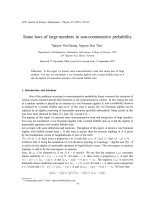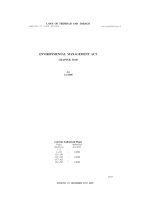Laws of exponents
Bạn đang xem bản rút gọn của tài liệu. Xem và tải ngay bản đầy đủ của tài liệu tại đây (228.46 KB, 19 trang )
Exponents
{5
exponent
3
Power
base
Example: 125 = 53 means that 53 is the exponential
form of the number 125.
53 means 3 factors of 5 or 5 x 5 x 5
The Laws of Exponents:
#1: Exponential form: The exponent of a power indicates
how many times the base multiplies itself.
x =1
x ×4
x ×4
x4××2
××x4×x4×x43
×x
n
n −times
n factors of x
Example: 5 = 5 ×5 ×5
3
#2: Multiplying Powers:
If you are multiplying Powers
with the same base, KEEP the BASE & ADD the EXPONENTS!
x ×x = x
m
So, I get it!
When you
multiply
Powers, you
add the
exponents!
n
m +n
26 × 23 = 2 6+3 = 29
= 512
#3: Dividing Powers: When dividing Powers with the
same base, KEEP the BASE & SUBTRACT the EXPONENTS!
m
x
m
n
m −n
=
x
÷
x
=
x
n
x
So, I get it!
When you
divide
Powers, you
subtract the
exponents!
6
2
6−2
4
=
2
=
2
2
2
= 16
Try these:
12
7.
1. 3 × 3 =
2
2
2. 52 × 54 =
3.
8.
a ×a =
5
2
4. 2 s × 4 s =
2
7
12 8
9.
5. (−3) × (−3) =
2
6.
3
s t ×s t =
2 4
7 3
s
=
4
s
9
3
=
5
3
s t
=
4 4
st
5 8
10.
36a b
=
4 5
4a b
SOLUTIONS
2
2+ 2
4
a ×a = a
5+ 2
=a
1. 3 × 3 = 3 = 3 = 81
2+ 4
6
2
4
=5
2. 5 × 5 = 5
2
3.
5
2
4. 2 s × 4 s = 2 × 4 × s
2
7
5. (−3) × (−3) = (−3)
2
6.
3
s t ×s t =
2 4
7 3
s
7
2+ 7
2+3
= 8s
= (−3) = −243
2+ 7 4+3
t
9
5
=s t
9 7
SOLUTIONS
12
7.
8.
9.
10.
s
12 − 4
8
s
=
s
=
4
s
9
3
9 −5
4
3
=
3
=
81
=
5
3
12 8
s t
12 − 4 8− 4
8 4
s
t
=
s
t
=
4 4
st
5 8
36a b
5 − 4 8 −5
3
36
÷
4
×
a
b
=
9
ab
=
4 5
4a b
#4: Power of a Power: If you are raising a Power to an
exponent, you multiply the exponents!
(x )
n
m
So, when I
take a Power
to a power, I
multiply the
exponents
=x
mn
(5 ) = 5
3
2
3×2
=5
5
#5: Product Law of Exponents: If the product of the
bases is powered by the same exponent, then the result is a
multiplication of individual factors of the product, each powered
by the given exponent.
( xy )
So, when I take
a Power of a
Product, I apply
the exponent to
all factors of
the product.
n
= x ×y
n
n
( ab) = a b
2
2
2
#6: Quotient Law of Exponents: If the quotient of the
bases is powered by the same exponent, then the result is both
numerator and denominator , each powered by the given exponent.
n
x
x
÷= n
y
y
So, when I take a
Power of a
Quotient, I apply
the exponent to
all parts of the
quotient.
n
4
4
16
2 2
= 4 =
81
3 3
Try these:
( )
1. 3
2. ( a
5
2 5
)
3 4
=
=
( ) =
4. ( 2 a b )
3. 2 a
s
7. =
t2
39
8. 5 =
3
2 3
2
5 3 2
5. (−3a ) =
2 2
6. ( s t
)
2 4 3
=
=
2
st
9. 4 =
rt
5 8 2
36a b
=
10.
4 5
4a b
8
SOLUTIONS
( )
1. 3
2 5
( )
2. a
3 4
=
(
2
3
a12
=
( )
3. 2a
10
2 3
3
= 2 a
)
5 3 2
4. 2 a b
2×3
= 8a
6
= 2 2×2 a 5×2b 3×2 = 2 4 a10b 6 = 16a10b 6
5. (−3a ) = ( − 3) × a
2×2
6. ( s t
6 12
2
2 2
)
2 4 3
2×3 4×3
=s t
=s t
= 9a
4
SOLUTIONS
5
s
7. =
t
5
s
5
t
2
3
8. 5 = 34
3
9
( )
2
=3
8
2
4 2
2 8
st
st
s
t
9. 4 =
= 2
r
rt
r
8
36a b
10
4 5
4a b
5 8
2
= 9ab 3
(
)
2
2 3×2
=9 a b
2
= 81a b
2 6
#7: Negative Law of Exponents: If the base is powered
by the negative exponent, then the base becomes reciprocal with the
positive exponent.
So, when I have a
Negative Exponent, I
switch the base to its
reciprocal with a
Positive Exponent.
Ha Ha!
If the base with the
negative exponent is in
the denominator, it
moves to the
numerator to lose its
negative sign!
x
−m
1
= m
x
1
1
5 = 3 =
5
125
and
−3
1
2
=
3
=9
−2
3
#8: Zero Law of Exponents: Any base powered by zero
exponent equals one.
x =1
0
So zero
factors of a
base equals 1.
That makes
sense! Every
power has a
coefficient
of 1.
50 =1
and
a 0 =1
and
(5a ) 0 =1
Try these:
1.
2.
3.
( 2a b )
2
0
=
y 2 × y −4 =
(a )
=
−2
7
5 −1
5. ( 3 x y
−2
6.
(s t
)
)
3 −4
2 4 0
=
=
−2
s t
9. 4 4 =
s t
−2
5
36a
10. 4 5 =
4a b
2 2
4. s × 4 s =
−1
2
7. =
x −2
39
8. 5 =
3
2
SOLUTIONS
(
)
0
1. 2 a b = 1
1
−2
2
−4
2. y × y = y = 2
y
1
5 −1
3. a
= 5
a
−2
7
5
4. s × 4 s = 4s
2
( )
5. ( 3 x y
−2
6. ( s t
)
)
3 −4
2 4 0
= (3 x y
= 1
−4
8
−12
x
) = 81y12
8
SOLUTIONS
−1
2
7.
x
9 −2
3
8. 5
3
2
−1
x
4
= x = 4
( )
= 3
−2
(
4 −2
1
=3 = 8
3
−8
)
s t
− 2 − 2 −2
4 4
=s t
9. 4 4 = s t
s t −2
10
5
b
−
2
−
2
10
36a
9
a
b
=
2
10. 4 5 =
81
a
4a b
2 2









